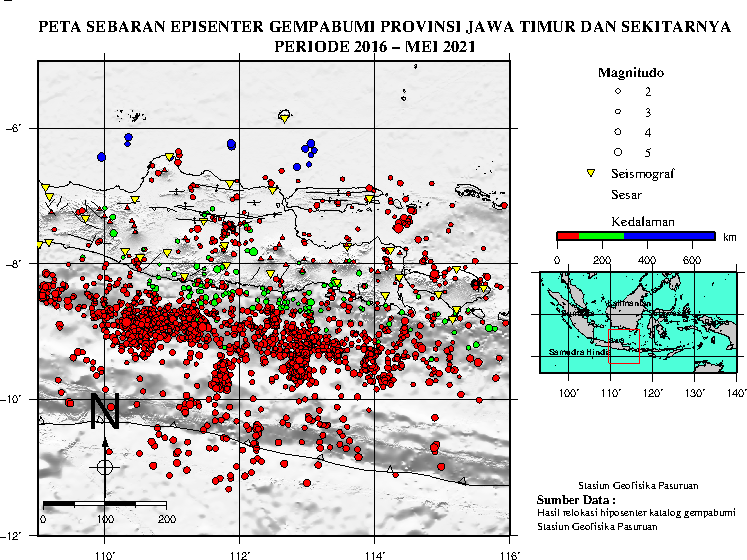Running HypoDD
- Tahapan ini adalah bagian inti dari relokasi hiposenter dengan Metode Double Difference yaitu running program HypoDD.
File yang harus dipersiapkan
file di luar folder
station.datberisi informasi stasiun yang digunakan.Jatim.phaberisi nilai travel time observasi yang dihasilkan dari tahap convert_data.
file di dalam folder ph2dt
ph2dt.inpberisi setting parameterph2dt.exeprogram untuk menghitung bla bla bla
file di dalam folder hypoDD
hypoDD.inpberisi setting parameterstation.datberisi informasi stasiun yang digunakan.event.dat,event.seldandt.ctmerupakan file output dari programph2dt.exeyanng menjadi input pada programhypoDD.exehypoDD.exeprogram untuk menghitung melakukan relokasi double difference
Langkah-langkah-langkah
- Siapkan file-file yang telah disebutkan di atas
- Buka terminal cygwin lalu masuk ke dalam folder
HypoDD/ph2dt/ - Jalan program
ph2dt.exedengan perintah
|
|
maka akan menghasilkan file
event.datberisi daftar event yang digunakan dalam penelitian.event.selberisi daftar event yang memenuhi kriteria pada setting parameterph2dt.inpdt.ctberisi nilai travel time relatif antara pasangan event.
- Pindahkan ke-3 file tersebut ke dalam folder
HypoDD - Ubah direktori kerja terminal cygwin ke dalam folder
HypoDD - Jalan program
hypoDD.exedengan perintah
|
|
maka akan menghasilkan file
hypoDD.reloc.001hypoDD.reloc.001.002hypoDD.reloc.00nbersisi parameter hiposenter hasil relokasi setep 1, 2 hingga stepnhypoDD.relocberisi parameter final hasil relokasihypoDD.staberisi koordinat stasiun yang digunakan dalam relokasihypoDD.resberisi nilai residuals
- Pindahkan file
hypoDD.relocke dalam folderPlot Resultuntuk tahap plotting
Membahas tutorial relokasi hiposenter menggunakan software HypoDD



ph2dt.inp
* ph2dt.inp - input control file for program ph2dt
* Input station file:
station.dat
* Input phase file:
Jatim1520.pha
*MINWGHT: min. pick weight allowed [0]
*MAXDIST: max. distance in km between event pair and stations [200]
*MAXSEP: max. hypocentral separation in km [10]
*MAXNGH: max. number of neighbors per event [10]
*MINLNK: min. number of links required to define a neighbor [8]
*MINOBS: min. number of links per pair saved [8]
*MAXOBS: max. number of links per pair saved [20]
*MINWGHT MAXDIST MAXSEP MAXNGH MINLNK MINOBS MAXOBS
0 500 100 50 8 8 32
reading data ...
> stations = 194
> events total = 3446
> events selected = 2535
> phases = 29794
forming dtimes...
> P-phase pairs total = 1609198
> S-phase pairs total = 648796
> outliers = 17211 ( 0%)
> phases at stations not in station list = 37260
> phases at distances larger than MAXDIST = 3346
> P-phase pairs selected = 250669 ( 15%)
> S-phase pairs selected = 117221 ( 18%)
> weakly linked events = 1726 ( 68%)
> linked event pairs = 42382
> average links per pair = 8
> average offset (km) betw. linked events = 49.3882446
> average offset (km) betw. strongly linked events = 49.3882446
> maximum offset (km) betw. strongly linked events = 99.9981079
Done.
Output files: dt.ct; event.dat; event.sel; ph2dt.log
ph2dt parameters were:
(minwght,maxdist,maxsep,maxngh,minlnk,minobs,maxobs)
0. 500. 100. 50 8 8 32
reading data ...
> stations = 295
> events total = 3446
> events selected = 2535
> phases = 29794
forming dtimes...
> P-phase pairs total = 1588484
> S-phase pairs total = 641853
> outliers = 17654 ( 0%)
> phases at stations not in station list = 0
> phases at distances larger than MAXDIST = 3341
> P-phase pairs selected = 273510 ( 17%)
> S-phase pairs selected = 124569 ( 19%)
> weakly linked events = 1674 ( 66%)
> linked event pairs = 45421
> average links per pair = 8
> average offset (km) betw. linked events = 49.756752
> average offset (km) betw. strongly linked events = 49.756752
> maximum offset (km) betw. strongly linked events = 99.9981079
Done.
Output files: dt.ct; event.dat; event.sel; ph2dt.log
ph2dt parameters were:
(minwght,maxdist,maxsep,maxngh,minlnk,minobs,maxobs)
0. 500. 100. 50 8 8 32